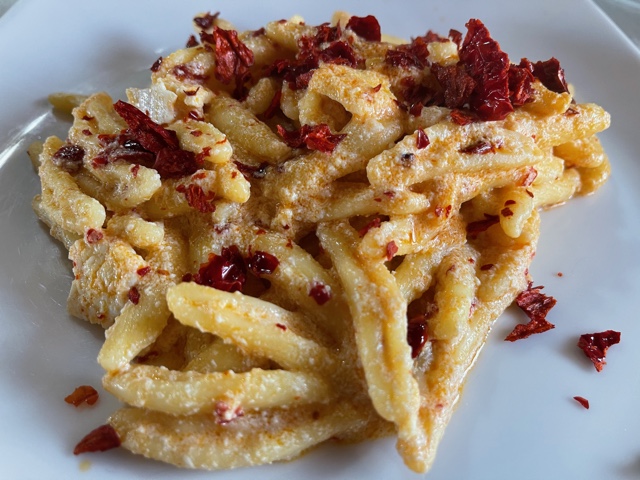Pasta, an Italian culinary wonder, has carved its place in the hearts and palates of people worldwide. With its versatile nature and endless possibilities, pasta has become a staple in countless kitchens, offering a delightful and satisfying meal for families, friends, and food enthusiasts alike. This article explores the fascinating history, diverse types, and enduring popularity of pasta, showcasing why it remains a beloved dish that transcends borders and cultures.
A Brief Journey Through Pasta’s Origins
Pasta’s origins can be traced back to ancient times, with evidence of its existence in different cultures. However, it was the Italians who perfected the art of pasta-making, turning it into an iconic element of their gastronomy. Legend has it that the great explorer Marco Polo introduced pasta to Italy upon his return from China, but historical evidence suggests that pasta was already well-established in Italy long before Marco Polo’s travels.
Types of Pasta
The exact number may vary as new varieties are occasionally added. However, as of my knowledge cutoff in September 2021, there were approximately 350 different types of registered pasta shapes in Italy. The registration and recognition of pasta shapes in Italy are overseen by organizations such as the Italian Association of Pasta Manufacturers (AIDEPI) and the Union of Organizations of Manufacturers of Pasta Products for the Italian Market (UNAFPA). These organizations work to preserve the authenticity and quality of Italian pasta, ensuring that traditional shapes and production methods are maintained.
It’s important to note that while there are hundreds of registered pasta shapes in Italy, there are also countless variations and regional specialties that may not be officially recognized but are still widely enjoyed and cherished across the country. Italians’ love for pasta continues to inspire creativity, leading to the creation of new shapes and combinations that further enrich the culinary landscape. There are numerous types of pasta available, each with its unique shape, size, and purpose.
We can divide pasta in 2 macro categories: Dry or Stuffed pasta. Among the dry pasta we can include:
Spaghetti: Long, thin cylindrical strands of pasta, commonly associated with Italian cuisine.
Penne: Short, tube-shaped pasta with diagonal ends and a hollow center, ideal for holding sauces.
Fusilli: Corkscrew-shaped pasta with twisted spirals, perfect for capturing and holding chunky sauces.
Rigatoni: Large, ridged tubes with straight edges, often used in baked pasta dishes.
Linguine: Similar to spaghetti but slightly wider and flatter, often paired with seafood or light sauces.
Farfalle: Bow-tie-shaped pasta with distinct folded edges, versatile and suitable for a range of sauces.
Orecchiette: Small, ear-shaped pasta, commonly associated with the Puglia region of Italy.
Pappardelle: Wide, ribbon-like pasta, perfect for hearty meat-based sauces.
Gnocchi: Soft, pillowy dumplings made from potatoes, flour.
Tagliatelle: Long, flat, ribbon-like pasta, similar to fettuccine, served especially with rich sauces.
Stuffed pasta include:
Ravioli: Square or round pockets of pasta filled with a variety of ingredients, such as cheese (ricotta, mozzarella, or Parmesan), meat (beef, pork, or chicken), vegetables (spinach, mushrooms), or a combination of these. Ravioli is typically served with a sauce, such as tomato or sage butter.
Tortellini: Small, ring-shaped pasta filled with a mixture of meat (usually pork), cheese (Parmigiano Reggiano). Tortellini is often served in a broth or with a tomato-based sauce.
Cappelletti: Resembling small hats or folded squares, cappelletti is similar to tortellini in shape but typically filled with a mixture of ground meat, cheese, and herbs. It is commonly served in a broth or with a light sauce.
Agnolotti: Square or rectangular pasta pockets, similar to ravioli, filled with various ingredients, such as cheese, meat, or vegetables. Agnolotti is often served with a butter-based sauce or a rich meat sauce.
Mezzelune: Half-moon-shaped pasta with a curved edge, typically filled with cheese, vegetables, or meat. Mezzelune can be served with a variety of sauces, including cream-based, tomato-based, or butter-based sauces.
Sacchetti: Resembling small pouches or purses, sacchetti is filled with ingredients like cheese, nuts, fruits, or herbs. It is often served with a delicate sauce, such as a sage and brown butter sauce.
Anolini: Traditional to the Emilia-Romagna region of Italy, anolini is a stuffed pasta similar to ravioli but often filled with a mixture of meat (pork or beef), cheese, breadcrumbs, and spices. It is commonly served in a broth.
Plin: Originating from the Piedmont region, plin is a small, hand-pinched pasta filled with meat, typically a mixture of roasted meats, vegetables, and herbs. Plin is often served with a light sauce or melted butter.
These are just a few examples of the vast range of pasta shapes available. From delicate strands to intricate shapes, pasta offers endless possibilities for creating delicious and satisfying meals. Whether you prefer classic varieties or explore more unique options, there is a pasta shape to suit every taste and culinary creation.
The Art of Pasta Preparation
Preparing pasta is an art form that requires attention to detail and a true understanding of the ingredients. The term “sfoglina” refers to a professional pasta maker, particularly in the region of Emilia-Romagna in Italy. Sfoglinas are highly skilled artisans who specialize in the craft of hand-rolling and shaping pasta dough. The word “sfoglia” in Italian means “sheet” or “leaf,” and it refers to the thin sheets of pasta that are the foundation of many traditional Italian pasta dishes.
Sfoglinas have a deep understanding of the pasta-making process, from selecting the right ingredients to achieving the perfect texture and consistency of the dough. They often use traditional techniques passed down through generations, relying on their hands and a rolling pin to create thin and uniform pasta sheets or shape stuffed pasta.
The role of the sfoglina is highly respected, as they contribute to the culinary heritage of their region and uphold the traditions associated with handmade pasta. Their expertise lies in achieving the desired thickness and elasticity of the dough, as well as creating a variety of pasta shapes and styles with precision and finesse.
Sfoglinas are known for their dedication, patience, and attention to detail, as the process of making pasta by hand requires time and skill. Their expertise ensures that the pasta they create is of the highest quality, with a texture and taste that is distinctively different from commercially produced pasta.
In recent years, the term “sfoglina” has gained broader recognition and appreciation outside of Italy, as the art of handmade pasta has become popularized and celebrated worldwide. Today, you can find professional sfoglinas in specialized pasta shops, high-end restaurants, and cooking schools, where they continue to preserve and promote the artistry and traditions of Italian pasta-making.
The quality of the pasta:
Pasta is primarily made by using 2 different kind of flour from Durum and Regular wheat, also known as common wheat. They differ significantly in their composition and characteristics when it comes to pasta making. Here are the key differences between the two:
Protein Content: Durum wheat is known for its high protein content, specifically gluten proteins, which are essential for pasta-making. It contains approximately 12-14% protein, whereas regular wheat typically has a lower protein content of around 9-12%. The higher protein content in durum wheat contributes to the desirable texture and structure of pasta.
Gluten Strength: The gluten proteins in durum wheat have a higher quality and strength compared to regular wheat. Gluten provides elasticity and enables the dough to stretch and hold its shape during pasta production. The stronger gluten in durum wheat allows for the formation of a firm and “al dente” pasta texture.
Durability and Cooking Tolerance: Due to its robust gluten structure, pasta made from durum wheat holds up well during cooking. It maintains its shape and texture without becoming mushy or falling apart. Regular wheat pasta may be more prone to overcooking, resulting in a softer and less resilient texture.
Flavor and Color: Durum wheat imparts a distinctive golden color to pasta, while regular wheat pasta tends to be paler in comparison. This natural hue adds visual appeal to dishes and enhances the overall sensory experience. Additionally, durum wheat pasta has a slightly nutty and rich flavor, complementing a wide range of sauces and ingredients.
Availability and Specific Use: Durum wheat is primarily cultivated for pasta production and is the preferred wheat variety for making high-quality pasta. Regular wheat, on the other hand, is more commonly used for bread, pastries, and other baked goods. Durum wheat is typically milled into semolina flour, which is specifically designed for pasta-making due to its coarser texture and ability to absorb water efficiently.
In summary, durum wheat stands out in pasta-making due to its higher protein content, stronger gluten quality, superior cooking tolerance, and characteristic golden color. These qualities make it the preferred choice for producing high-quality pasta with excellent texture, flavor, and durability. Regular wheat, while suitable for various culinary applications, may not offer the same desirable attributes when it comes to pasta production.
The drying process also plays a crucial role in achieving the desired texture, flavor, and cooking properties. Slow drying and oven drying are two different methods commonly used, each with its own advantages and characteristics. Let’s explore the importance of each method:
Slow Drying:
Slow drying allows the pasta to dry gradually at a lower temperature over an extended period. This slow and gentle process helps to maintain the ideal texture of the pasta. It allows the moisture within the pasta to evaporate slowly, resulting in a firm, al dente texture when cooked. The gradual drying also helps to prevent the pasta from becoming brittle or overly dry, it also allows the pasta to undergo a natural fermentation process, which can contribute to flavor development. The slow evaporation of moisture helps concentrate the flavors within the pasta, resulting in a richer and more complex taste. Slow drying helps to preserve the nutritional qualities of the pasta. The extended drying time helps to retain the nutrients present in the wheat and other ingredients used in the pasta-making process.
Oven Drying:
Efficiency and Time-Saving: Oven drying is a quicker method often used by large industries. It involves placing the pasta in a heated oven to speed up the drying process, which can be advantageous in commercial settings where large quantities of pasta need to be dried within a shorter timeframe. Oven drying provides a controlled environment, allowing for consistent and predictable results. The heat distribution in the oven ensures that the pasta dries evenly, reducing the risk of uneven textures or potential spoilage. Oven-dried pasta typically has a longer shelf life compared to slow-dried pasta. The rapid drying process helps to remove moisture more efficiently, reducing the chances of microbial growth and extending the pasta’s shelf stability.
Both slow drying and oven drying methods have their own merits, and the choice depends on factors such as the scale of production, desired texture, flavor preferences, and time constraints. While slow drying is often associated with traditional pasta-making techniques and can result in superior texture and flavor, oven drying offers convenience and efficiency for large-scale production while still maintaining a discrete quality.
The Health Benefits of Pasta:
Contrary to popular belief, pasta can be a part of a healthy and balanced diet. It is a source of complex carbohydrates, which provide sustained energy and essential nutrients. Additionally, whole wheat and gluten-free pasta options are widely available, catering to specific dietary needs. When paired with nutrient-rich sauces and toppings, pasta can become a wholesome and nourishing meal. Pasta, when consumed as part of a balanced diet, can offer several health benefits. Pasta made from wheat flour, containes a complex carbohydrate. Complex carbohydrates provide a slow and steady release of energy, helping to sustain energy levels throughout the day. Pasta contains important nutrients such as fiber, protein, B-vitamins (such as folate and thiamine), and minerals like iron and selenium.
Pasta made from whole wheat or whole grain flour is a good source of dietary fiber. Fiber aids in digestion, promotes satiety (feeling of fullness), and helps maintain a healthy digestive system. It can also assist in managing weight and reducing the risk of chronic conditions like heart disease, diabetes, and certain types of cancer.
Pasta itself is naturally low in fat, particularly when compared to other staples like meat or cheese-based dishes. However, the overall fat content of pasta-based meals can vary depending on the sauces and toppings used. Pasta provides a versatile base that can be combined with a variety of nutrient-rich ingredients. By incorporating vegetables, lean proteins (such as chicken, fish, or legumes), and healthy fats (such as olive oil or nuts), pasta dishes can become well-rounded meals with a balance of essential nutrients. Pasta is a staple of the Mediterranean diet, which has been associated with various health benefits, including reduced risk of heart disease, improved weight management, and overall longevity. The Mediterranean diet emphasizes whole foods, plant-based ingredients, and moderation in portions.
Beyond Traditional Italian Fare:
While Italy remains the epitome of pasta culture, this delightful dish has seamlessly integrated itself into various cuisines around the world. In American households, spaghetti with meatballs has become a beloved classic, while Mexican cuisine features pasta in flavorful dishes like fideo and sopa seca. Asian cuisines have also adopted pasta, resulting in delectable fusion creations such as Thai-inspired peanut noodles and Japanese ramen.
Ultimately, in this article we have ascertained that the quality of the pasta relies on various factors, including the quality of ingredients, the pasta-making process, the drying method employed, and the cooking process. Pairing the right shape of pasta with the right sauce, be it a hearty ragù, a cheesy Alfredo, or a vibrant pesto, enhances the overall flavor profile and brings the dish to life. Therefore do not base your choice in purchasing pasta solely and exclusively on the price, but read the label carefully, in order to understand the raw materials used and the certifications attributed to that particular product or brand. Always remember that IGP or DOP are symbols that guarantee and confirm superior quality and the country of origin.
Pasta is a versatile and popular food that can be enjoyed in various forms and dishes, but as with any food, it’s advisable to consult healthcare professionals or registered dietitians for personalized dietary guidance. With proper attention to ingredients, preparation methods, and portion control, pasta can be a delicious and satisfying addition to a healthy lifestyle.
Write me on attilio.borra@fbmagazine.co if you like to have suggestions on how to make fresh pasta or you if you just want to know more about making your favorite pasta recipe. I hope you enjoyed this article, and as always until next time, I’ll see you in the Kitchen.








